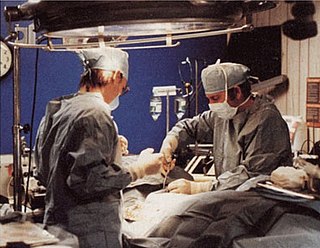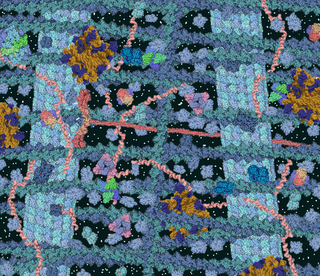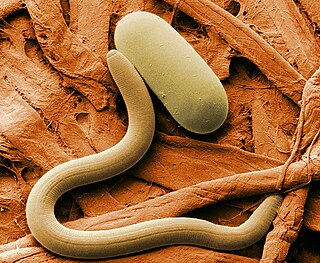Related Research Articles

Cryonics is the low-temperature freezing and storage of human remains, with the speculative hope that resurrection may be possible in the future. Cryonics is regarded with skepticism within the mainstream scientific community. It is generally viewed as a pseudoscience, and its practice has been characterized as quackery.

The cytosol, also known as cytoplasmic matrix or groundplasm, is one of the liquids found inside cells. It is separated into compartments by membranes. For example, the mitochondrial matrix separates the mitochondrion into many compartments.

The University of California, San Diego is a public land-grant research university in San Diego, California, United States. Established in 1960 near the pre-existing Scripps Institution of Oceanography, UC San Diego is the southernmost of the ten campuses of the University of California, and offers over 200 undergraduate and graduate degree programs, enrolling 33,096 undergraduate and 9,872 graduate students. The university occupies 2,178 acres (881 ha) near the coast of the Pacific Ocean, with the main campus resting on approximately 1,152 acres (466 ha).

The rotifers, commonly called wheel animals or wheel animalcules, make up a phylum of microscopic and near-microscopic pseudocoelomate animals.
Cryobiology is the branch of biology that studies the effects of low temperatures on living things within Earth's cryosphere or in science. The word cryobiology is derived from the Greek words κρῧος [kryos], "cold", βίος [bios], "life", and λόγος [logos], "word". In practice, cryobiology is the study of biological material or systems at temperatures below normal. Materials or systems studied may include proteins, cells, tissues, organs, or whole organisms. Temperatures may range from moderately hypothermic conditions to cryogenic temperatures.

Cryptobiosis or anabiosis is a metabolic state in extremophilic organisms in response to adverse environmental conditions such as desiccation, freezing, and oxygen deficiency. In the cryptobiotic state, all measurable metabolic processes stop, preventing reproduction, development, and repair. When environmental conditions return to being hospitable, the organism will return to its metabolic state of life as it was prior to cryptobiosis.
A cryoprotectant is a substance used to protect biological tissue from freezing damage. Arctic and Antarctic insects, fish and amphibians create cryoprotectants in their bodies to minimize freezing damage during cold winter periods. Cryoprotectants are also used to preserve living materials in the study of biology and to preserve food products.

The eastern diamondback rattlesnake is a species of pit viper in the family Viperidae. The species is endemic to the Southeastern United States. It is one of the heaviest venomous snakes in the Americas and the largest rattlesnake. No subspecies are recognized.
The theca folliculi comprise a layer of the ovarian follicles. They appear as the follicles become secondary follicles.

Microfauna refers to microscopic animals and organisms that exhibit animal-like qualities, and have body sizes that are usually <0.1mm. Microfauna are represented in the animal kingdom and the protist kingdom. A large amount of microfauna are soil microfauna which includes protists, rotifers, and nematodes. These types of animal-like protists are heterotrophic, largely feeding on bacteria. However, some microfauna can consume other things, making them detritivores, fungivores, or even predators.

A eurytherm is an organism, often an endotherm, that can function at a wide range of ambient temperatures. To be considered a eurytherm, all stages of an organism's life cycle must be considered, including juvenile and larval stages. These wide ranges of tolerable temperatures are directly derived from the tolerance of a given eurythermal organism's proteins. Extreme examples of eurytherms include Tardigrades (Tardigrada), the desert pupfish, and green crabs, however, nearly all mammals, including humans, are considered eurytherms. Eurythermy can be an evolutionary advantage: adaptations to cold temperatures, called cold-eurythemy, are seen as essential for the survival of species during ice ages. In addition, the ability to survive in a wide range of temperatures increases a species' ability to inhabit other areas, an advantage for natural selection.

Cord factor, or trehalose dimycolate (TDM), is a glycolipid molecule found in the cell wall of Mycobacterium tuberculosis and similar species. It is the primary lipid found on the exterior of M. tuberculosis cells. Cord factor influences the arrangement of M. tuberculosis cells into long and slender formations, giving its name. Cord factor is virulent towards mammalian cells and critical for survival of M. tuberculosis in hosts, but not outside of hosts. Cord factor has been observed to influence immune responses, induce the formation of granulomas, and inhibit tumor growth. The antimycobacterial drug SQ109 is thought to inhibit TDM production levels and in this way disrupts its cell wall assembly.

Cryopreservation or cryoconservation is a process where biological material - cells, tissues, or organs - are frozen to preserve the material for an extended period of time. At low temperatures any cell metabolism which might cause damage to the biological material in question is effectively stopped. Cryopreservation is an effective way to transport biological samples over long distances, store samples for prolonged periods of time, and create a bank of samples for users. Molecules, referred to as cryoprotective agents (CPAs), are added to reduce the osmotic shock and physical stresses cells undergo in the freezing process. Some cryoprotective agents used in research are inspired by plants and animals in nature that have unique cold tolerance to survive harsh winters, including: trees, wood frogs, and tardigrades.The first human corpse to be frozen with the hope of future resurrection was James Bedford's, a few hours after his cancer-caused death in 1967.[15] Bedford's is the only cryonics corpse frozen before 1974 still frozen today.

Tardigrades, known colloquially as water bears or moss piglets, are a phylum of eight-legged segmented micro-animals. They were first described by the German zoologist Johann August Ephraim Goeze in 1773, who called them Kleiner Wasserbär. In 1777, the Italian biologist Lazzaro Spallanzani named them Tardigrada, which means "slow steppers".

Jennifer Lippincott-Schwartz is a Senior Group Leader at Howard Hughes Medical Institute's Janelia Research Campus and a founding member of the Neuronal Cell Biology Program at Janelia. Previously, she was the Chief of the Section on Organelle Biology in the Cell Biology and Metabolism Program, in the Division of Intramural Research in the Eunice Kennedy Shriver National Institute of Child Health and Human Development at the National Institutes of Health from 1993 to 2016. Lippincott-Schwartz received her PhD from Johns Hopkins University, and performed post-doctoral training with Richard Klausner at the NICHD, NIH in Bethesda, Maryland.
Robert Price Higgins was an American systematic invertebrate zoologist and ecologist, who specialized in the unusual taxa of kinorhynchs and tardigrades.

The goldenrod gall fly, also known as the goldenrod ball gallmaker, is a species of fly native to North America. The species is best known for the characteristic galls it forms on several species in the Solidago, or goldenrod, genus. The fly's eggs are inserted near the developing buds of the plant. After hatching, the larvae migrate to an area below the plant's developing buds, where they then induce the plant's tissues to form into the hardened, bulbous chamber referred to as a gall. E. solidaginis’s interactions with its host plant(s) and insect, as well as avian, predators have made it the centerpiece of much ecological and evolutionary biology research, and its tolerance of freezing temperatures has inspired studies into the anti-freeze properties of its biochemistry.
Stephen H. Wright is an American physiologist. He is primarily known for his work on the mechanisms of organic solute transport in kidney tubules, but he is also known for work to describe transport of organic solutes across epithelial membranes by marine invertebrates.
References
- ↑ "Lois M. Crowe" . Retrieved 27 Dec 2020.
- 1 2 "John and Lois Crowe Honored with UC Davis Medal". University of California, Davis. Retrieved 27 Dec 2020.
- 1 2 "An Interview with John H. Crowe and Robert D. Grey". University of California, Davis. Retrieved 20 Dec 2020.
- ↑ Howler Yearbook 1965, Wake Forest University, Winston-Salem, NC. pg. 216
- ↑ "Irwin Mayer Newell (1916-1979)". University of California, Riverside. Retrieved 27 Dec 2020.
- ↑ Ancestry.com. California, U.S., Marriage Index, 1960-1985 [database on-line]. Provo, UT, USA: Ancestry.com Operations Inc, 2007. State of California. California Marriage Index, 1960-1985. Microfiche. Center for Health Statistics, California Department of Health Services, Sacramento, California.